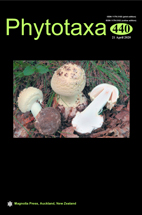Abstract
Tetrapyrgos is characterized by small basidiomata which have a mostly whitish pileus, a well-defined central or eccentric, mostly dark greyish stipe, a non- or very weakly gelatinous pileipellis and pileus tramal tissues; the pileipellis is composed of Rameales-like structures, and the basidiospores are distinctly tetrahedral. Members of this genus are commonly found on dead leaves and woody debris on the floor of tropical and subtropical forests. Recent studies suggest changes in the circumscription of Tetrapyrgos and Campanella Still poorly documented, to date, only about 18 species have been assigned to Tetrapyrgos. Through integrative taxonomy, we describe six new species from the Brazilian Amazon, based on evidence from morphological and ITS data. Tetrapyrgos longicystidiata is formally synonymized in T. atrocyanea.

